BTO create and publish a variety of important articles, papers, journals and other publications, independently and with our partners, for organisations, government and the private sector. Some of our publications (books, guides and atlases) are also available to buy in our online shop.
Annual report of the Seabird Monitoring Programme
Seabird Population Trends and Causes of Change: 1986–2023
This report presents the latest seabird population trends in breeding abundance and productivity using data from the Seabird Monitoring Programme (SMP).
The report documents changes in the abundance and productivity of breeding seabird species in Britain and Ireland from 1986 to 2023, and provides a detailed account of the 2021, 2022 and 2023 breeding seasons.

Search settings
Large-scale spatial variation in the breeding performance of song thrushes Turdus philomelos and blackbirds T. merula in Britain
Author: Paradis, E., Baillie, S.R., Sutherland, W.J., Dudley, C., Crick, H.Q.P. & Gregory, R.D. .
Published: 2000
01.01.00
Papers
Declining coastal bird populations in Great Britain: victims of climate change and sea-level rise?
Author: Norris, K & Atkinson, P.W.
Published: 2000
Is sea-level rise and (or) climate change responsible for current declines in important coastal bird populations in Great Britain, and how might these processes affect bird populations in future? We review the current status of coastal bird populations in Britain and identify two important species, Common Redshank (Tringa totanus) and Twite (Carduelis flavirostris), whose populations are currently declining. We then review the evidence relating to the causes of these declines. There is evidence that habitat loss, driven by sea-level rise and climate change (e.g., an increase in wind and wave energy reaching the coast due to an increase in the frequency of storms), could have contributed to the decline in Twite. Common Redshank numbers are declining because of changes in grazing management, not sea-level rise. Populations that are currently stable or increasing, such as wintering waders and wildfowl, might in future experience declines in abundance because there is a link between climate, food supply, and bird abundance. There are insufficient reliable data at present to allow us to predict future changes with any confidence. Sea-level rise and climate change are currently important issues facing coastal zone management in Great Britain, and these issues may become even more pressing in future. But, in addition to these environmental processes, coastal bird populations are affected by a range of other anthropogenic factors. Conservationists, therefore, need to identify important bird populations that are (or could be in future) detrimentally affected by any of these activities rather than focusing exclusively on single issues such as sea-level rise. Allowing the sea to breach existing sea defences, thereby creating new saltmarsh, provides a way forward but is not without its practical and political difficulties.
01.01.00
Papers
The Breeding Bird Survey 1998
Author: Noble, D.G., Bashford, R.I., Marchant, J. H., Baillie, S.R. & Gregory, R.D.
Published: 1999
This is the fourth annual report of the BTOTNCC/RSPB Breeding Bird Survey (BBS), covering the years 1997 to 1998 and detailing progress since the scheme's introduction in 1994. The primary aim of the survey is to provide population trends for a range of common and widespread birds in the UK.
01.08.99
Reports BBS Report
